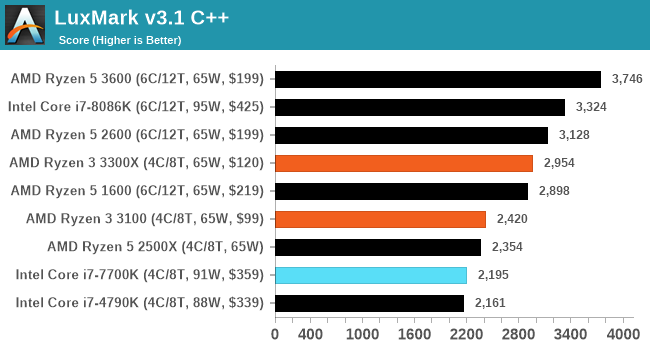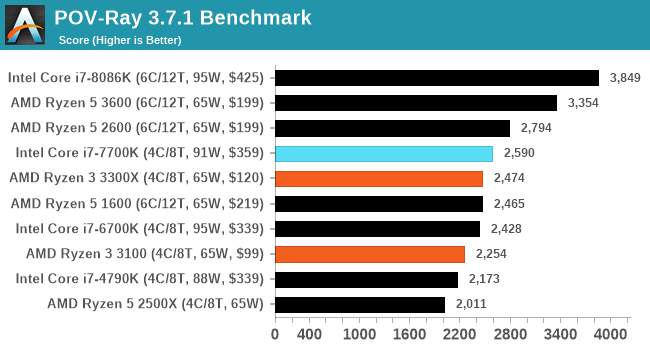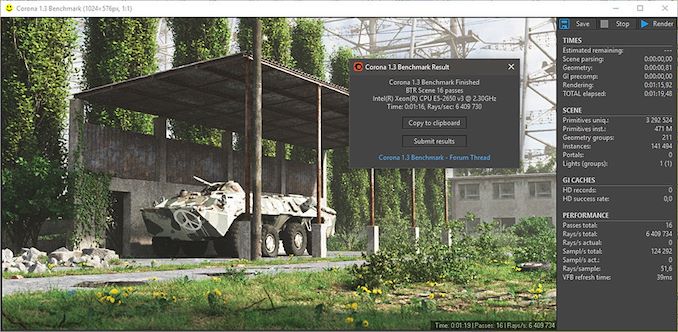The AMD Ryzen 3 3300X and 3100 CPU Review: A Budget Gaming Bonanza
by Dr. Ian Cutress on May 7, 2020 9:00 AM ESTCPU Performance: Rendering Tests
Rendering is often a key target for processor workloads, lending itself to a professional environment. It comes in different formats as well, from 3D rendering through rasterization, such as games, or by ray tracing, and invokes the ability of the software to manage meshes, textures, collisions, aliasing, physics (in animations), and discarding unnecessary work. Most renderers offer CPU code paths, while a few use GPUs and select environments use FPGAs or dedicated ASICs. For big studios however, CPUs are still the hardware of choice.
All of our benchmark results can also be found in our benchmark engine, Bench.
Corona 1.3: Performance Render
An advanced performance based renderer for software such as 3ds Max and Cinema 4D, the Corona benchmark renders a generated scene as a standard under its 1.3 software version. Normally the GUI implementation of the benchmark shows the scene being built, and allows the user to upload the result as a ‘time to complete’.
We got in contact with the developer who gave us a command line version of the benchmark that does a direct output of results. Rather than reporting time, we report the average number of rays per second across six runs, as the performance scaling of a result per unit time is typically visually easier to understand.
The Corona benchmark website can be found at https://corona-renderer.com/benchmark

LuxMark v3.1: LuxRender via Different Code Paths
As stated at the top, there are many different ways to process rendering data: CPU, GPU, Accelerator, and others. On top of that, there are many frameworks and APIs in which to program, depending on how the software will be used. LuxMark, a benchmark developed using the LuxRender engine, offers several different scenes and APIs.
In our test, we run the simple ‘Ball’ scene on both the C++ and OpenCL code paths, but in CPU mode. This scene starts with a rough render and slowly improves the quality over two minutes, giving a final result in what is essentially an average ‘kilorays per second’.

POV-Ray 3.7.1: Ray Tracing
The Persistence of Vision ray tracing engine is another well-known benchmarking tool, which was in a state of relative hibernation until AMD released its Zen processors, to which suddenly both Intel and AMD were submitting code to the main branch of the open source project. For our test, we use the built-in benchmark for all-cores, called from the command line.
POV-Ray can be downloaded from http://www.povray.org/












249 Comments
View All Comments
PeterCollier - Thursday, May 7, 2020 - link
Ugh, how much did Intel pay you for this article?kulareddy - Thursday, May 7, 2020 - link
How much did AMD pay you for this comment?callmebob - Thursday, May 7, 2020 - link
They paid him with old new stock of a dozen 1st gen Bulldozer CPUs.Just having the AMD logo on them will make him blissfully happy. No need to waste good products on him ;-)
kulareddy - Thursday, May 7, 2020 - link
👏👏👏PeterCollier - Saturday, May 9, 2020 - link
This makes no sense.Teckk - Thursday, May 7, 2020 - link
I genuinely want to understand why you think so?You really believe this article puts Intel's chips in a good light?
Would've preferred to see a set of different/recent processors in comparison but your comment is confusing lol.
Teckk - Thursday, May 7, 2020 - link
Arghhh .. meant as a reply to @PeterCollierkulareddy - Thursday, May 7, 2020 - link
👍PeterCollier - Friday, May 8, 2020 - link
Yestwtech - Friday, May 8, 2020 - link
I guess one point might be that in most of the comparisons, there are no higher-end AMD CPUs included. So you see that Intel's higher-end processors are better for gaming, but not that there are AMD options as well further up the chain.Even so, I think Intel holds the gaming FPS crown anyway for the moment, with their new 10900k (which isn't on this chart). That 5.3 boost clock should be pretty good for achieving maximal framerates.
Other than losing to Intel at max-FPS gaming though, AMD dominates all segments from a price/performance, raw performance, and power efficiency performance. Server, mobile, workstation, gaming, etc.